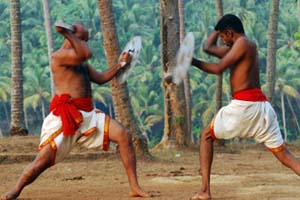Oral folklore attribute the creation of kalari payat to the gods. It was first documented around the 11th or 12th century AD by the historian Elamkulam Kunjan Pillai. The art was disseminated through schools known as kalari, which served as centres of learning before the modern educational system was introduced. Still in existence, kalaris served as meeting places for the acquisition of knowledge on various subjects ranging from mathematics, language, astronomy and various theatrical arts. More specifically, martial artswere taught in the payattu kalari, meaning fight school (kalari- Training place, payattu - training)
Kalaripayattu is believed to be the prototype of many Martial arts. Martial arts like Judo, Karate and Tae-kwon-do etc have roots in Kalari Payattu. In earlier times Kalaripayattu was practiced to improve the fighting skill by the warriors in the armies of the Kings and Warlords of Kerala.The fighting ring is the pitch where the disciples of Kalaripayattu display their combating skill. Kalaripayattu martial art is also practiced by dancers as it helps to build flexibility and agility.

Kalaripayattu is closely associated with yoga and Ayurveda. Massage with ayurvedic oils is an essential part of the Kalaripayattu routine. This martial art form has special cure for arthritis, broken bones and joints. Kalaripayattu martial art helps to systemize the flow of energy in the body. Kalaripayattu martial art encompasses an invigorating Ayurvedic herbal treatment for chronic ailments like arthritis and spondylitis and a massaging therapy which repairs physiological damages and helps the body stay young and supple.




